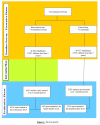Implementation of Home based management of malaria in children reduces the work load for peripheral health facilities in a rural district of Burkina Faso
- PMID: 18834504
- PMCID: PMC2570683
- DOI: 10.1186/1475-2875-7-201
Implementation of Home based management of malaria in children reduces the work load for peripheral health facilities in a rural district of Burkina Faso
Abstract
Background: Home Management of Malaria (HMM) is one of the key strategies to reduce the burden of malaria for vulnerable population in endemic countries. It is based on the evidence that well-trained communities health workers can provide prompt and adequate care to patients close to their homes. The strategy has been shown to reduce malaria mortality and severe morbidity and has been adopted by the World Health Organization as a cornerstone of malaria control in Africa. However, the potential fall-out of this community-based strategy on the work burden at the peripheral health facilities level has never been investigated.
Methods: A two-arm interventional study was conducted in a rural health district of Burkina Faso. The HMM strategy has been implemented in seven community clinics catchment's area (intervention arm). For the other seven community clinics in the control arm, no HMM intervention was implemented. In each of the study arms, presumptive treatment was provided for episodes of fevers/malaria (defined operationally as malaria). The study drug was artemether-lumefantrine, which was sold at a subsidized price by community health workers/Key opinion leaders at the community level and by the pharmacists at the health facility level. The outcome measured was the proportion of malaria cases among all health facility attendance (all causes diseases) in both arms throughout the high transmission season.
Results: A total of 7,621 children were enrolled in the intervention arm and 7,605 in the control arm. During the study period, the proportions of malaria cases among all health facility attendance (all causes diseases) were 21.0%, (445/2,111, 95% CI [19.3%-22.7%]) and 70.7% (2,595/3,671, 95% CI 68.5%-71.5%), respectively in the intervention and control arms (p << 0.0001). The relative risk ratio for a fever/malaria episode to be treated at the HF level was 30% (0.30 < RR < 0.32). The number of malaria episodes treated in the intervention arm was much higher than in the control arm (6,661 vs. 2,595), with malaria accounting for 87.4% of all disease episodes recorded in the intervention area and for 34.1% in the control area (P < 0.0001). Of all the malaria cases treated in the intervention arm, only 6.7% were treated at the health facility level.
Conclusion: These findings suggest that implementation of HMM, by reducing the workload in health facilities, might contributes to an overall increase of the performance of the peripheral health facilities.
Figures
References
-
- Breman JG, Alilio MS, Mills A. Conquering the intolerable burden of malaria: what's new, what's needed: A summary. Am J Trop Med Hyg. 2004;71:1–15. - PubMed
-
- WHO The African Summit on Roll Back Malaria, Abuja, Nigeria. WHO/CDS/RBM/200017 25 April 2000.
-
- WHO The Roll Back Malaria strategy for improving access to treatment trough home management of malaria. WHO/HTM/MAL/20051101.
Publication types
MeSH terms
Substances
LinkOut - more resources
Full Text Sources
Research Materials
Miscellaneous



